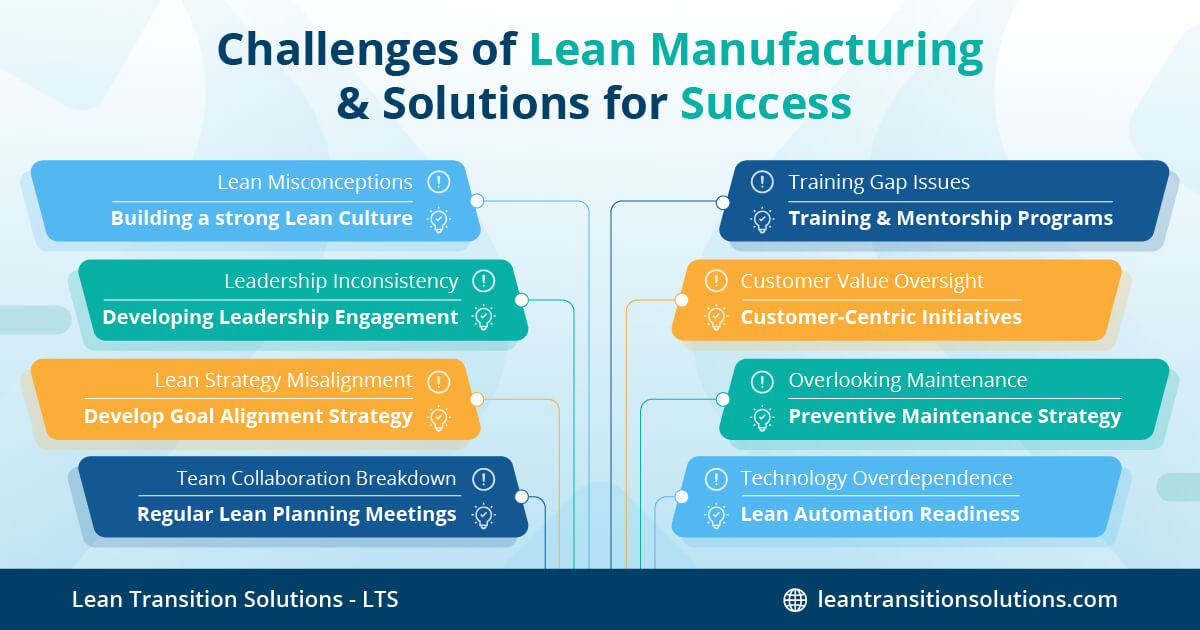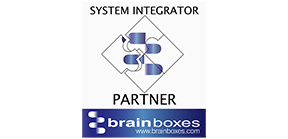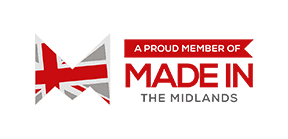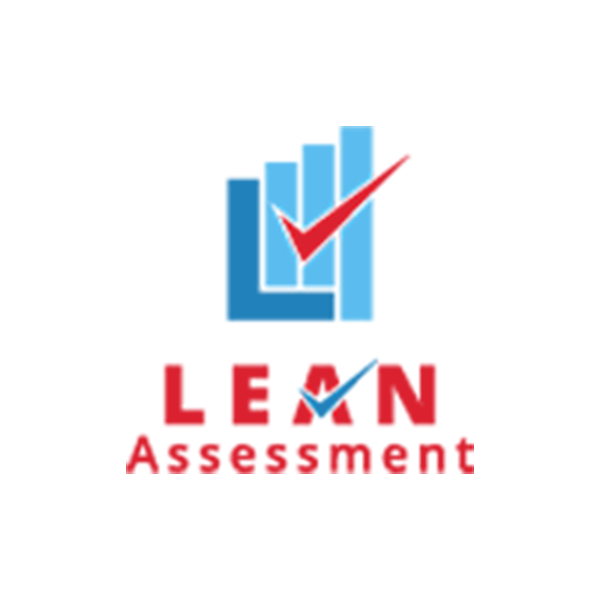Challenges of Lean Manufacturing & Strategies to Overcome
- By Brett Griffiths
- Lean Technology
- November 07 , 2024
- Share
 "Every block of stone has a statue inside it, and it is the task of the sculptor to release it", Michelangelo once said.
"Every block of stone has a statue inside it, and it is the task of the sculptor to release it", Michelangelo once said.Yes, Lean Manufacturing is like sculpting; the stone here is the production process. Manufacturing without waste is the central idea of Lean Manufacturing, and it aims to reduce the time between customer orders and deliveries. It is the responsibility of businesses to chisel away the waste or inefficiencies to uncover a smooth, efficient operation.
Taiichi Ohno, Father of Lean Manufacturing, defined the seven wastes as;
- Overproduction
- Waiting (of operator, material or machine)
- Excess motion
- Excess processing
- Transportation
- Inventory
- Defects (rework and scrap)
However, many firms make mistakes in their Lean journey. Implementation of Lean Manufacturing programs in the right way requires proper planning and execution deeply rooted in Lean principles. Companies implement Lean programs to cut waste, optimise resources and save money.
But when adopted improperly this may result in:
- Increased Waste and Inefficiency: Lack of efficient Lean management leads to excess inventory, overproduction, unnecessary transportation, etc.
- Delayed Decision-Making: When teams are not aligned through Lean methods, there will be increased bottlenecks, slow response to market demands and longer lead times.
- Inconsistent Product Quality: Inadequate standardised processes cause unnoticed defects, product recalls, customer dissatisfaction and financial losses.
- Cost Overruns and Budget Mismanagement: Mismanagement of Lean tools results in inefficient resource allocation and higher operational costs.
- Low Employee Morale and Engagement: Improper integration of Lean principles in communication leads to demotivation and a decrease in morale and productivity.
Common Challenges That Affect Lean Manufacturing
1. Misunderstanding the Purpose of Lean Tools
The holistic philosophy of Lean is waste reduction and continuous improvement. However, some organisations give their sole focus only on Lean tools rather than adopting Lean as their business philosophy. Lack of knowledge about the purpose of Lean tools among the team doesn't make sustainable improvement.
Solution
- Build a strong base of Lean culture rather than focusing only on tools
- Give ongoing Education about Lean
- Maintain Open Communication
- Consistent supplementing of Lean principles
2. Inconsistent Leadership Commitment
What if leaders only look for output rather than following Lean practices, including 5S methodology or Kaizen (Continuous Improvement)?
The traction of Lean initiatives will be lost if there is inconsistent leadership. Many team members resist change, and leaders are needed to guide the team towards Lean Manufacturing principles. Continuous support is essential on the part of the leaders to empower floor operators. If not, teams will go back to their old style of working, which will result in the loss of competitive edge.
Solution
- Develop an actively engaged leadership team
- Encourage Lean culture through events
- Review performance metrics
- Analyse the improvements
- Discuss the achievements through Lean practices with employees
3. Failure to Align Lean with Long-Term Strategy
The absence of alignment of lean practices with long-term strategic goals like market competitiveness, sustainability, or innovation makes lean efforts futile. If Lean practices move away from business objectives, there will be no progress and competitive advantage.
For example, imagine a plant that increases potential through Just-In-Time (JIT) production but not focusing on long goals such as capacity flexibility or new product lines.
Solution
- Align Lean goals with the company's vision, mission and overall goals
- Focus on goals such as product quality enhancement and reducing lead times
- Develop Proper Action Plan
4. Lack of Cross-Functional Collaboration
Interdepartmental Synergy, which is the collaboration between departments, is the core concept of lean. The lack of alignment with the departments of Production, Quality Control, Supply Chain and sales creates difficulty in identifying issues, supplies and needs. This will disrupt the production flow.
Solution
- Conduct regular Lean planning meetings
- Share the performance metrics for every department
- Encourage open Communication
5. Lack of Training and Knowledge Transfer
No proper training for workers causes a shortfall in the success of Lean programs. Without structured training modules, it is impossible to use digital work tools, continuous improvement philosophies and processes with effect. If the employees can't grasp the methods 5S, Kaizen, and Total Productive Maintenance (TPM), there will be no problem identification, solution proposal, or further improvements.
Solution
- Give practical on-board training and skill development programs
- Collect feedback from employees
- Collect feedback from employees
6. Neglecting Customer Value in Lean Decisions
Even though Lean is primarily focused on waste reduction, some organisations mistakenly put emphasis on cost-cutting and internal processes without considering its effect on customer experience. For example, lowering Work-in-Progress (WIP) inventory might save costs but may lead to longer wait times for custom orders. This will result in a decline in market share due to customer dissatisfaction.
Solution
- Ensure implementing only customer-centric Lean initiatives
- Focus more on customer experience and product quality
7. Overlooking Maintenance and Equipment Reliability
To eliminate waste, firms may overlook the significance of maintaining equipment reliability. Improper maintenance may result in unplanned downtime and halt the entire production.
Solution
- Focus on preventive maintenance
- Applying Total Productive Maintenance (TPM) as part of the Lean strategy
8. Over-reliance on Technology without Process Improvement
Without optimising the fundamental procedures through Lean principles first, Lean organisations may give more importance to embracing digital tools and automating processes. Automating an ineffective assembly line with technologies such as ERP systems, Industry 4.0 tools and IoT without analysing root causes creates waste and defects.
Solution
- Before jumping to automation, manufacturers must focus on Lean problem-solving techniques, including root cause analysis and thinking.
- Make sure that Lean practices are improving with technological advancements.
Tools and Techniques for Advancing Lean Manufacturing
- Balanced Scorecard Software: A Balanced Scorecard (BSC) evaluates businesses and provides a balanced idea regarding how well the organisation performs. It visualises the entire business process, enables strategic management, provides real-time data, and leads to operational excellence.
- 5S Audit and Assessment Software: 5s Audits enhance efficiency and organisation through Sort, Set in Order, Shine, Standardise, and Sustain.
- T Card Software: Provide visual control and enhance task management through the T-shaped cards in digital format.
- Kanban Software: Optimise workflow management and productivity through limiting Work in Progress (WIP) and implement visual workflows.
- CMMS Software (Computerised Maintenance Management System): The CMMS system maintains a computerised database of information about an organisation's maintenance operations. It helps schedule, plan, track, and optimise maintenance activities, ensuring minimal downtime and extending equipment life.
- Gemba: Gemba walk is the direct observation of the process by leaders and the bringing out solutions. The templates for the Gemba walk provide a structured framework for the leaders to identify, engage and make improvements on the shop floor.
- Poka-Yoke (Error Proofing): Enhance product quality and reliability by integrating mechanisms to avoid errors at the source.
Incorporating the tools that are appropriate to your workflow can bring potential changes and progress in your Lean Manufacturing practices.
Conquer Your Organisational Challenges and Drive Success with Lean Manufacturing
Lean technology is a cornerstone in the manufacturing industry for optimising processes and delivering high-quality products with minimum cost. However, adopting Lean as a business methodology is associated with some challenges. Even though these challenges can significantly affect your Lean practices, they can be easily tackled by better management and execution programs.
Lean is a continuous improvement strategy, and it needs proper accomplishment beyond just following the basics. The common missteps in different parts of the organisation, including Neglecting interdepartmental collaboration, Inconsistent leadership engagement, Lack of employee empowerment, Ineffective performance measurement and Resistance to change, hinder Lean success. In addition, Misunderstanding the Purpose of Lean Tools, Overlooking Maintenance and Equipment Reliability, Neglecting Customer value in Lean decisions, and Failure to Align Lean Manufacturing techniques with a long-term strategy make the manufacturing process extend beyond Lean principles into day-to-day operations.
Manufacturers can foster long-term growth by easily overcoming these challenges by continuously investing in Lean methods and following and embedding Lean principles in everyday practices, from the production floor to supply chain management. Additionally, incorporating practical tools and techniques such as Kanban and JIT, Balanced Scorecard, T Card, Total Productive Maintenance (TPM), CMMS Software, 5S, Kaizen, Gemba Walks and so on can accelerate Lean Manufacturing.
×
Start Free Trial
LEAN TRANSITION SOLUTIONS
The Old Vicarage, Pershore Road, Upton Snodsbury, Worcester, Worcestershire, WR7 4NR, United Kingdom.
BLOG
►
Lean Transition Solution
-
Lean Industry 4.0 Solutions
- TITAN:Computerised Maintenance Management System
- Data Point:Computerised Balanced Scorecard
- Janus: Automated Shop-floor Data Capture System
- T-Card: Integrated Production Planning and Plant Level Execution System
- JDI: Maintenance Automation App
- Maximus: Integrated ERP System
- e-Contractor: Integrated In-house Contractor Management System
- Q-Point: Integrated Quality Management System
- Safety-Point: Integrated Health and Safety Management System
- Lean Assessment: Lean Audit and Assessment System
- Saisho: Lean 5S Audit and Assessment App
- Emergency Response App: To Manage Emergency Situations
-
Leadership 4.0 Solutions
- Your Career Academy(YCA): Learning and Development System
- YCA e-Learning : Management System
- MentorYou(MU): Mentoring App
- Leadership 4.0 : Leadership Transformation Program
- Lean Manufacturing Workshop
- Lean Manufacturing Consulting
- ILM Accredited Green Belt Training and Certification Program
- ILM Accredited Black Belt Training and Certification Program
- Software Development Service
- Resources
- Company
- Contact











